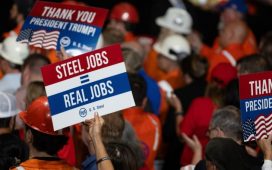Receive free Chinese business & finance updates
We’ll send you a myFT Daily Digest email rounding up the latest Chinese business & finance news every morning.
Chinese property developer Shimao Group Holdings paid Rmb24bn ($3.3bn) in 2017 for land earmarked for a prestige commercial project that would be dominated by a 500-metre-tall skyscraper, with commanding views of Shenzhen.
The price was a record at the time for the fast-growing southern city that borders Hong Kong, but six years on, those plans are unrealised and the land was put back up for sale this month at a heavily discounted $1.8bn. Yet it still received no bids in the online auction ordered by a Beijing court after Shimao had defaulted on its debts.
The undeveloped and unwanted plot is one among many examples of a paralysis that has for almost two years gripped a real estate industry that is critical to China’s economy.
For decades, private developers such as Shimao, Evergrande, Kaisa and Sunac had spearheaded China’s urbanisation process. But from late 2021 onwards, they began defaulting on the vast debts they had accumulated. Ever since, they have struggled to raise funds or have failed to relieve the pressure on themselves through sales of assets.
Beijing offered the industry a package of tentative support measures in November, which it reiterated and partly extended this week. It includes the easing of rules for property acquisitions and the extension of debts. But its efforts have so far failed to revive market activity — from purchases of land to new funding — across an industry that for years was driven by the private sector.
“What we’re seeing is a complete lack of trust emerging in the Chinese property sector,” said Andrew Lawrence, Asia property analyst at TS Lombard.
Long before the crisis, the Chinese government had sought to limit the property sector’s expansion to avoid overheating land prices. Its campaign culminated in the so-called “three red lines” policy introduced in 2020 that limited leverage at individual developers and ultimately curtailed their access to financing.

This led to a wave of defaults that ground construction activity to a halt and has divided the sector into designated victims of the cash crunch and those considered able to survive it. This means government measures so far have typically directed cautious levels of support towards “high quality” developers rather than those that have defaulted and remain caught up in drawn-out and opaque restructuring processes with international creditors. The latest such episode involves Kaisa, which this week was subject to a winding-up petition from an investor in Singapore.
“The funding model for Chinese developers is broken and there isn’t anything to replace it,” said Lawrence. “Ultimately they’re going to get to the point where they’ve got nothing to sell and they’ve got no revenue.”
One example of fresh government support is a push to authorise new share issuance, which last month saw developers China Poly and China Merchants Shekou gain approval from the China Securities Regulatory Commission to issue $1.8bn and $2.4bn in shares, respectively. While the move is a significant change in tack from Beijing after years of discouraging property industry equity issuance, analysts suggest it is unlikely to have an impact.
“We don’t really think this will make a very big difference,” said Kaven Tsang, a vice-president at Moody’s, which rates several large developers. “The amount of funding that can be raised through the equity market will not be very substantial compared to the scale of operations of these companies.”
The Shekou deal also highlights a reliance on the government in the absence of market activity, given that the new shares will be sold to a branch of the Shenzhen government — a practice reflected in other property sector activity, including construction.
Construction in big Chinese cities is ongoing, but many of the high-quality developers that are able to continue have state support. Even then, the recent deterioration in activity has sparked alarm. The chair of Vanke, a leading developer not fully state-owned but partly owned by the Shenzhen metro system, struck a pessimistic tone at a shareholder meeting two weeks ago. “The real situation is worse than expected,” said Yu Liang in comments that contrasted with his previous outlook in March.

Ting Lu, chief China economist at Nomura, points to data from the China Real Estate Information Corporation (CRIC), which shows sales volumes at the country’s top 100 developers fell by a third in June year on year, compared with a decline of 21.2 per cent in May. Those declines come against a period last year when activity was already suppressed.
Beijing’s approach has been to prioritise completing projects, many of which are residential and politically sensitive — an imperative so pervasive that it has acquired its own special three-character expression, “bao jiao lou”, across state media. It has also sought to delay any further debt crunch. Last November, when top financial regulators unveiled their 16-point plan to support the sector, they included a measure to extend all loans coming due until May. This week, they said that loans due before the end of 2024 could be extended for a year.
Economists at HSBC suggested the measures represented “a critical step in instilling market confidence”, but others are more pessimistic.
Lu at Nomura noted that the 16-point measures had reversed most of the financing-tightening measures for the property sector, but argued they were “unlikely to sufficiently stimulate home purchases”.
Meanwhile, there are few signs of a recovery of appetite for bonds in domestic or international markets. In Hong Kong, once a booming market for offshore China developer bonds, one investor says the “whole market is scaling down” and that long-only investors are now underweight the sector, in stark contrast to before the crisis.
Lawrence at TS Lombard suggests that the main international focus now should be on the Chinese banking sector, where more developer defaults would increase rates of non-performing loans and shift scrutiny to their financial health. Last month, the minister of housing Ni Hong met Ge Haijiao, chair of state-owned Bank of China, and requested further support for completing projects.
For the heavily indebted companies that originated them, both government support and their future survival is less clear cut. Back in 2017, when Shimao bought its Shenzhen plot, President Xi Jinping declared that houses “are for living in, not for speculation”.
“It would be very difficult for Xi, given his mantra . . . to then do a massive bailout of overleveraged developers,” said Lombard’s Lawrence.
Additional reporting by Wang Xueqiao in Shanghai and Andy Lin in Hong Kong










